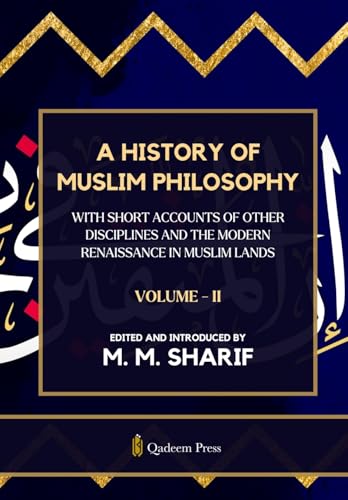A History Of Muslim Philosophy – Vol. 2
Mian Mohammad Sharif
Paperback, 1012 Pages, Black & White
6.69 x 9.61 Inches
Qadeem Press
Delve into the profound depths of Islamic intellectual heritage with A History of Muslim Philosophy – 2 by M. M. Sharif, an illuminating journey through centuries of philosophical evolution in the Muslim world. This comprehensive volume not only captures the essence of Muslim thought but also provides insightful glimpses into other disciplines and the modern renaissance in Muslim lands, making it an indispensable resource for scholars, students, and anyone passionate about philosophy and history.
Volume II of this seminal work spans from the fall of Baghdad in 1258 to the threshold of the 18th century. The fall of the ‘Abbasid Caliphate, a pivotal moment in Islamic history, sets the stage for the exploration of a rich tapestry of intellectual and cultural developments that followed. This volume is meticulously structured into thematic sections, each offering an in-depth analysis of significant philosophers, theologians, Sufi mystics, and their contributions to various fields of knowledge.
Explore the profound ideas of theologians and philosophers like Ibn Taimiyyah, whose works continue to influence contemporary Islamic thought. Understand the intricate interplay between faith and reason that characterized this period and how it shaped the discourse in Muslim societies. Immerse yourself in the spiritual wisdom of Sufi masters such as Jalal al-Din Rumi, whose poetry and teachings transcend time, and Mahmüd Shabistari, al-Jili, and Jāmi, whose contributions to Sufi philosophy are meticulously analyzed. Discover the mystical paths that offered a unique perspective on divine love and existential contemplation.
Learn about the lives and ideas of prominent philosophers like Jalal al-Din Dawwani and Ibn Khaldūn, the latter being celebrated for his groundbreaking work in sociology and historiography. The book also sheds light on the intellectual revival that blended philosophy with metaphysical insights, particularly through the School of Ispahan and Şadr al-Din Shirazi (Mulla Şadra). Understand the evolution of political thought through the eyes of Ibn Khaldūn and others who dissected the dynamics of power, governance, and society. The comprehensive analysis extends to other disciplines, offering detailed accounts of advancements in language, literature, fine arts, social studies, and the sciences.
The latter part of the book transitions to the modern renaissance in Muslim lands, highlighting key figures and movements that sparked intellectual and cultural revivals across the Near and Middle East, North Africa, and South and South-East Asia. From Muhammad Bin ‘Abd al-Wahhab in Arabia to Sir Sayyid Ahmad Khân in Indo-Pakistan, the renaissance section chronicles the resurgence of Muslim thought and its adaptation to contemporary challenges. Concluding with an exploration of the influence of Muslim thought on both Western and Eastern intellectual traditions, the book underscores the enduring legacy of Islamic philosophy and its contributions to global civilization.
Table of Contents
VOLUME II
Book Four: LATER CENTURIES
(From the Fall of Baghdad [656/1258] to 1111/1700)
Part 1. THE FALL OF BAGHDAD
XL. Fall of the ‘Abbasid Caliphate
Part 2. THEOLOGICO-PHILOSOPHICAL THOUGHT
XLI. Ibn Taimiyyah
Part 3. THE SUFIS
XLII. Jalal al-Din Rümi
XLIII. Mahmüd Shabistari, al-Jili, and Jāmi
XLIV. Shaikh Ahmad Sirhindi
Part 4. THE “PHILOSOPHERS”
XLV. Jalal al-Din Dawwani
XLVI. Ibn Khaldūn
Part 5. THE MIDDLE-ROADERS
XLVII. The School of Ispahan
XLVIII. Şadr al-Din Shirazi (Mulla Şadra)
Part 6. POLITICAL THOUGHT
XLIX. Ibn Khaldūn
Book Five: OTHER DISCIPLINES
(Covering Both the Early and the Later Centuries)
Part 1. LANGUAGE AND LITERATURE
L. Arabic Literature: Poetic and Prose Forms
LI. Arabic Literature: Grammar and Lexicography
LII. Arabic Literature: Theories of Literary Criticism
LIII. Persian Literature
LIV. Turkish Literature
Part 2. FINE ARTS
LV. Architecture
A. The First Three Centuries of Muslim Architecture
B. Muslim Architecture in Later Centuries
LVI. Painting
LVII. Music
A. Music (Continued)
LVIII. Minor Arts
Part 3. SOCIAL STUDIES
LX. Historiography
LXI. Jurisprudence
Part 4. THE SCIENCES
LXII. Geography
LXIII. Mathematics and Astronomy
LXIV. Physics and Mineralogy
LXV. Chemistry
LXVI. Natural History
LXVII. Medicine
Book Six: INFLUENCE OF MUSLIM THOUGHT
LXVIII. Influence of Muslim Thought on the West
A. Western Thinkers on Islam in General
B. Theological Influence
C. Philosophical Influence before Descartes
D. Philosophical Influence from Descartes to Kant
E. Philosophical Influence in the Post-Kantian Period
LXIX. Influence of Muslim Thought on the East
Book Seven: THE DARK AGE
(1111/1700-1266/1850)
LXX. Decline in the Muslim World
LXXI. The Silver Lining: Development of the Urdu Language, Grammar, and Literature
Book Eight: MODERN RENAISSANCE
Part 1. RENAISSANCE IN THE NEAR AND MIDDLE EAST
LXXII. Renaissance in Arabia, Yemen, Iraq, Syria, and Lebanon: Muhammad Bin ‘Abd al-Wahhab and His Movement
LXXIII. Renaissance in North Africa: The Sanüsiyyah Movement
LXXIV. Jamal al-Din al-Afghani
LXXV. Renaissance in Egypt: Muhammad ‘Abduh and His School
LXXVI. Renaissance in Turkey: Zia Gökalp and His School
LXXVII. Renaissance in Iran: General
LXXVIII. Renaissance in Iran (Continued): Haji Mulla Hadi Sabziwāri
Part 2. RENAISSANCE IN SOUTH AND SOUTH-EAST ASIA
LXXIX. Renaissance in Indo-Pakistan: Shah Wali Allah Dihlawi
LXXX. Renaissance in Indo-Pakistan (Continued): Sir Sayyid Ahmad Khân as a Politician, Historian, and Reformist
LXXXI. Renaissance in Indo-Pakistan (Continued): Sir Sayyid Ahmad Khân as a Religio-Philosophical Thinker
LXXXII. Renaissance in Indo-Pakistan (Continued): Iqbal
LXXXIII. Renaissance in Indonesia





